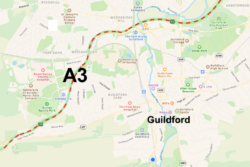 Abraham Lincoln
If given the truth, the people can be depended upon to meet any national crisis...
Abraham Lincoln
If given the truth, the people can be depended upon to meet any national crisis...
 Guildford news...
for Guildford people, brought to you by Guildford reporters - Guildford's own news service
Guildford news...
for Guildford people, brought to you by Guildford reporters - Guildford's own news service
Opinion: Local Plan Review Must Reassess Population Predictions and Housing Targets
Published on: 16 May, 2023
Updated on: 18 May, 2023
Guildford Borough Council has undertaken to carry out a review of the Local Plan. The review, necessary to be carried out in any case after five years of its adoption will include a full update and reassessment of the relevant evidence base including the ONS population projections.
 It will follow a report by the Office for Statistics Regulation (OSR) in which they raised some significant concerns, particularly that the population estimates for some university cities and towns, such as Coventry and Guildford, did indeed seem to be inconsistent with local evidence, and potentially higher than the evidence would suggest.
It will follow a report by the Office for Statistics Regulation (OSR) in which they raised some significant concerns, particularly that the population estimates for some university cities and towns, such as Coventry and Guildford, did indeed seem to be inconsistent with local evidence, and potentially higher than the evidence would suggest.
In my view, the following six issues alone give sufficient reason to question the Local Plan with its aim to build 562 dwellings per year and release 1,200 hectares of the green belt for development.
 1. Housing targets The housing targets adopted in the Local Plan are based on population projections which, according to the OSR Report released in July 2021, are likely to be overstated. In a letter to the council, Ed Humpherson, director-general for regulation at the OSR, said that “we found that the population estimates for some cities [sic], such as Guildford, did seem to be inconsistent with, and potentially higher than local evidence would suggest”.
1. Housing targets The housing targets adopted in the Local Plan are based on population projections which, according to the OSR Report released in July 2021, are likely to be overstated. In a letter to the council, Ed Humpherson, director-general for regulation at the OSR, said that “we found that the population estimates for some cities [sic], such as Guildford, did seem to be inconsistent with, and potentially higher than local evidence would suggest”.
The most likely explanation for this inconsistency is (a) that the ONS counts students as resident at their term-time address rather than their home address and (b) that the ONS is unable to accurately count overseas students returning home on completion of their studies.
2. Risk of increased target Some people argue that a review of the housing target will only result in a much higher figure because current legislation requires local authorities to assess their housing need by using the “Standard Method for calculating Housing and Economic Need Assessment”.
 However, the National Planning Policy Framework (NPPF) states “that the use of the Standard Method to calculate housing need is not mandatory but where an alternative approach results in a lower housing need figure than that identified using the standard method, the strategic policy-making authority will need to demonstrate, using robust evidence, that the figure is based on realistic assumptions of demographic growth”.
However, the National Planning Policy Framework (NPPF) states “that the use of the Standard Method to calculate housing need is not mandatory but where an alternative approach results in a lower housing need figure than that identified using the standard method, the strategic policy-making authority will need to demonstrate, using robust evidence, that the figure is based on realistic assumptions of demographic growth”.
The latest “household projections” released from the ONS predict a need for only 94 dwellings per annum in Guildford over the next 20 years – not 562 dwellings per annum in the adopted Local Plan. In my opinion, the latest official household projections would certainly be regarded as “robust evidence”.
 3. Incorrect target The proposed housing target of 562 dwellings per annum represents an uplift of 80 per cent over the demographically-led housing need of only 313 dwellings per annum. This is because the demographically-led need is boosted by factors to allow for economic growth and growth in student numbers.
3. Incorrect target The proposed housing target of 562 dwellings per annum represents an uplift of 80 per cent over the demographically-led housing need of only 313 dwellings per annum. This is because the demographically-led need is boosted by factors to allow for economic growth and growth in student numbers.
In addition, the total site allocations in the Local Plan have the potential to deliver 14,602 homes over the life of the plan. This contrasts with the total housing requirement of only 10,678 homes over the life of the plan. This represents a very substantial oversupply of land for development and questions whether there are sufficient “exceptional circumstances” to justify building on so much of the green belt.
 4. No A3 upgrade now planned Highways England no longer has any plans to improve or upgrade the A3 as it runs through Guildford which was a stated condition for inclusion of the strategic sites at Blackwell Farm and Gosden Hill Farm. With the unlikelihood of the new railway stations at Park Barn and Merrow now going ahead, there would appear to be insufficient infrastructure to support these developments.
4. No A3 upgrade now planned Highways England no longer has any plans to improve or upgrade the A3 as it runs through Guildford which was a stated condition for inclusion of the strategic sites at Blackwell Farm and Gosden Hill Farm. With the unlikelihood of the new railway stations at Park Barn and Merrow now going ahead, there would appear to be insufficient infrastructure to support these developments.
 5. Pollution levels The A3 as it passes through Guildford is one of the most congested and polluted A roads in the whole of the UK. Highways England has conducted a series of pollution surveys which show the pollution on the A3 as it passes through Guildford appears to be the highest in the country by some margin and twice the median level of the thirty worst places. This has the potential to undermine the health and well-being of the people served by this corridor.
5. Pollution levels The A3 as it passes through Guildford is one of the most congested and polluted A roads in the whole of the UK. Highways England has conducted a series of pollution surveys which show the pollution on the A3 as it passes through Guildford appears to be the highest in the country by some margin and twice the median level of the thirty worst places. This has the potential to undermine the health and well-being of the people served by this corridor.
Developing Blackwell Farm and Gosden Hill Farm without any improvements to the A3 will only increase traffic congestion and illegally intensify air pollution.
 6. Global warming Global warming is an issue to be taken very seriously indeed, by all of us. The very act of building on the green belt, by destroying natural habitat and forcing more people to commute, does more harm than good.
6. Global warming Global warming is an issue to be taken very seriously indeed, by all of us. The very act of building on the green belt, by destroying natural habitat and forcing more people to commute, does more harm than good.
According to the Royal Institute of Chartered Surveyors, about 50 per cent of the whole-life carbon emissions of a typical domestic dwelling are expended during the manufacture of the materials used in its construction like bricks, steel, glass and cement.
Bearing in mind that many scientists now believe that green fields and meadows are an even more resilient carbon sink than forests, building on the green belt only serves to intensify carbon emissions while reducing carbon sinks. Rather than endlessly developing green field sites, we should be doing our utmost to repurpose buildings and preserve natural habitat and biodiversity.
One of the dangers of overstating housing targets is that it can, and will, be used by planning inspectors at appeals to justify further development on green field sites because we are not meeting our housing targets.
It will also be used by developers to justify overdevelopment in the town centre as is happening at North Street, St Mary’s Wharf and the Solum development at Guildford Station, and a number of other developments in the pipeline planned for the town centre where most of the accommodation is in the form of flats which are quite unsuitable for young families.
People say we need to increase the supply of housing to make them more affordable. Asking the private sector to increase supply to make housing more affordable is a bit like asking Jaguar Land Rover to increase the supply of Range Rovers to make them more affordable. That isn’t going to happen.
An increase in the supply of affordable housing will only be realised when the government:
- enables councils to borrow money to build more housing for a subsidised rent – in other words, start
building more council housing again; - ends the “right to buy” policy which sells off council housing without replacing it;
- makes subletting council houses a criminal offence and enforces it;
- adjusts the tax system further to deter the “buy to let” market;
- prohibits homeowners placing their properties on Airbnb is areas where there is a shortage of affordable housing for the local population;
- prohibits speculation in the residential market by non-UK residents – which is a big issue in London and Manchester;
- requires all universities to provide adequate accommodation for their students;
- fully embraces and incentivises prefabrication in the construction industry which is long overdue;
- finds a way of encouraging elderly people locked into in large properties to downsize.
Responses to Opinion: Local Plan Review Must Reassess Population Predictions and Housing Targets
Leave a Comment Cancel replyPlease see our comments policy. All comments are moderated and may take time to appear.
Recent Articles
- Guildford Institute’s Crowdfunding Project for Accessible Toilet in its New Community and Wellbeing Centre
- Letter: Guildford – Another Opportunity Missed?
- Letter: GBC’s Corporate Strategy – Where Is the Ambition?
- My Memories of John Mayall at a Ground-breaking Gig in Guildford Nearly Six Decades Ago
- Westborough HMO Plans ‘Losing the Heart of the Street’ Says Resident
- College Invests to Boost Surrey’s Economy and Close Digital Skills Gap
- Community Lottery Brings Big Wins for Local Charities
- GBC Housing Plan Promises ‘A Vibrant Urban Neighbourhood’ Near Town Centre
- Hospital Pillows ‘Shortage’ at the Royal Surrey
- Updated: Caravans Set Up Camp at Ash Manor School


Recent Comments
- Ian Macpherson on Updated: Main Guildford to Godalming Road Closed Until August 1
- Sara Tokunaga on GBC Housing Plan Promises ‘A Vibrant Urban Neighbourhood’ Near Town Centre
- Michael Courtnage on Daily Mail Online Reports Guildford Has Highest-paid Council Officer
- Alan Judge on GBC Housing Plan Promises ‘A Vibrant Urban Neighbourhood’ Near Town Centre
- John Perkins on GBC Housing Plan Promises ‘A Vibrant Urban Neighbourhood’ Near Town Centre
- S Collins on GBC Housing Plan Promises ‘A Vibrant Urban Neighbourhood’ Near Town Centre
Search in Site
Media Gallery
Dragon Interview: Local Artist Leaves Her Mark At One of England’s Most Historic Buildings
January 21, 2023 / No Comment / Read MoreDragon Interview: Lib Dem Planning Chair: ‘Current Policy Doesn’t Work for Local People’
January 19, 2023 / No Comment / Read MoreA3 Tunnel in Guildford ‘Necessary’ for New Homes, Says Guildford’s MP
January 10, 2023 / No Comment / Read More‘Madness’ for London Road Scheme to Go Ahead Against ‘Huge Opposition’, Says SCC Leader
January 6, 2023 / No Comment / Read MoreCouncillor’s Son Starts Campaign for More Consultation on North Street Plan
December 30, 2022 / No Comment / Read MoreCounty Council Climbs Down Over London Road Works – Further ‘Engagement’ Period Announced
December 14, 2022 / No Comment / Read MoreDragon Interview: GBC Reaction to the Government’s Expected Decision to Relax Housing Targets
December 7, 2022 / No Comment / Read MoreHow Can Our Town Centre Businesses Recover? Watch the Shop Front Debate
May 18, 2020 / No Comment / Read More










Jules Cranwell
May 17, 2023 at 7:58 am
This is self-evident. The borough cannot afford to continue with its current trajectory.
However, I am not convinced that the new Lib Dem leadership has the talent or courage to take this on.
Perhaps they would have the good grace to tell us what, if anything, they plan to do with this ruinous Local Plan?
Or will their leader stay as silent as before the election on this subject?
K White
May 18, 2023 at 8:57 am
Valuable brownfield sites have been lost to residential development in the last few years due to their development for commercial student accommodation. The university can’t be allowed to continue expanding its population without limit (at a faster rate than the population of the town) and without providing accommodation within its campus.
Housing requirement projections should not include student numbers. Is there any evidence that building such commercial student accommodation has actually freed up any other housing for residential occupation as has been forecast?
Nathan Cassidy
May 18, 2023 at 9:09 am
It’s exasperating reading somebody correctly highlight the adverse effects of constructing car-dependent sprawl on the green belt, including increased pollution, traffic, and environmental damage, but then proceed to criticize the brownfield development of North Street.
The only way to save the green belt is to allow dense housing in the centre of Guildford – unless you have no wishes of young people ever owning a home. Of course, the flats aren’t going to be suitable for all families, but they will relieve the demand placed on single-family homes currently being shared by multiple young professionals.